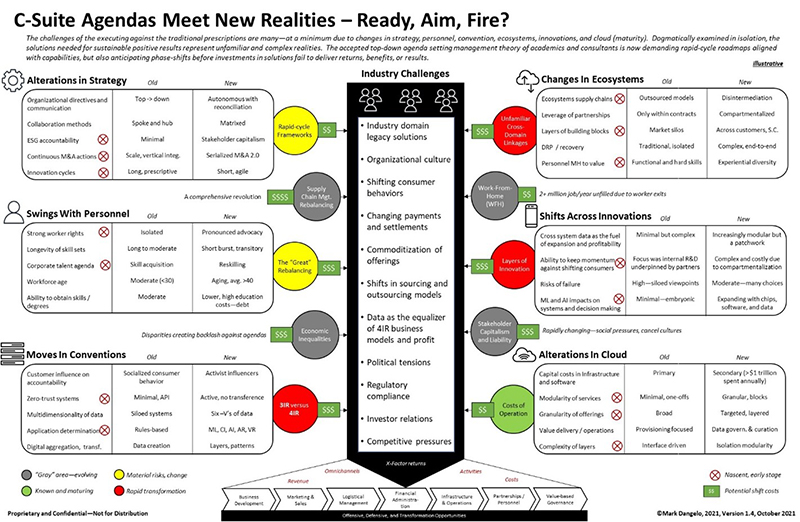
Mark P. Dangelo: 2022 C-Suite Agendas Meet New Realities
Mark P. Dangelo is Chief Innovation Officer with Innovation Expertus, Cleveland, Ohio, responsible for leading and managing global experiential teams for business transformations, digital projects and innovation-based advisory services. He is also president of MPD Organizations LLC and an adjunct professor of graduate studies in innovation and entrepreneurship at John Carroll University. He is the author of five innovation books and numerous articles and a regular contributor to MBA NewsLink. He can be reached at mark@mpdangelo.com or at 440/725-9402.

So, what will 2022 bring for c-levels seeking to be disruptive, anticipatory, or even efficient? Will there be further escalation of M&A events driven by demands for vast quantities of curated data? Will ML, CI and AI expand making skills and job functions obsolete—as 7 out of the top 10 careers of the next decade are unknown? Where should we focus resources to ensure product and service efficacy, while avoiding the uncertainty and risks that threaten to derail growth? The list of probing questions seemingly goes on and on—yet what are the critical foci?
As we anticipate 2022, the traditional processes used to develop the c-suite of solutions, which sets the agendas for growth and delivery across partners and employees, feels out-of-phase with new realities. Indeed, our ability to deploy multi-faceted cloud solutions has never been greater. Indeed, we have more digital information on customers and transactions than ever thought possible—all the while data volume, velocity, variability, validity, value and variety (the “six-V’s”) expands. Indeed, the cycle of growth with Covid as the catalyst has created broken supply chains, rapid-cycle innovations, and an employee bill-of-demands that were unanticipated prior to 2020.
Now after nearly two years of work-from-home, the ecosystems which are increasingly used to deliver financial solutions spread across varied retailers, currencies, and banks are transforming domain competencies resulting in compartmentalized, building block functionality. Moreover, alterations of strategy, a once familiar core competency, are demanding iterative, burst solutions that are in alignment with serialized M&A events and ESG accountability.
For financial services leaders, it is the non-traditional competitors who are comprehensively disrupting all aspects of consumer and business delivery. However, each of the above points of transformation are siloed within the enterprise resulting in less-than-optimal responses and anticipatory planning.
It is said that a picture is worth a thousand words. If that is typical, then the diagram following represents an x-factor of that tradition. The shifts when taken holistically represent a widespread and continuous shift of what it means to deliver financial products and services to consumers regardless of simple cash transactions to investment activity to home lending.
The cascading impacts of these new c-suite challenges is something different, and the use of traditional prescriptions to define “what is next” is precisely why non-traditional competitors are reducing existing brand value and product efficacy of BFS (banking, financial services) firms clinging to dogmatic approaches. The landscape has changed and so does the c-suite agendas for 2022 and beyond.

As shown in the informational graphic above, there are six areas of concentration for c-suite agendas delivering against new market realities; 1) Alterations in Strategy, 2) Swings with Personnel, 3) Moves in Conventions, 4) Changes in Ecosystems, 5) Shifts across Innovations, and 6) Alterations in Cloud. All six show the drivers of change from the “old” to the “new” with some of the criteria still themselves being embryonic.
Another category added to the holistic viewpoints are the anticipated agenda cost shifts impacting not only future budgets, but ones that will alter existing approaches, skills, and market applicability. Adding to these shifts are the common industry challenges which must be mitigated to arrive at x-factor returns. Following the arrow, what you notice at the bottom center are more traditional value chain realities what often flow into areas of budgeting and dashboard reporting.
The rationale for creating a diagram of this complexity, versus many which only convey a single idea or theme, is that the complexity of future BFS offerings cannot continue to adhere to siloed representation of c-suite agenda processes. The complexity of our environment coupled with external factors of social representation, pandemics, and consumer behaviors precede regulatory compliance, demographics served, and technological progression. No amount of lobbying or marketing will materially change the shifts that should be anticipated across c-suite agendas moving forward.
So as we move into this fourth quarter, we can talk about Samhain, a Charlie Brown Thanksgiving or Santa Claus bring joy as we furiously work through our internal processes of defining 2022 initiatives or allocating funds. We can rejoice in our industry meetings and face-to-face conferences and seminar sessions providing c-suite executives with a familiar communication vehicle to create relationships and expand product and service appeal. We can plan for a return to normal against worrisome economic indicators and consumer shifts in habits and wealth. However, this hope for familiarity may represent a “miracle” that will not be realized.
For BFS firms, 2022 may be the historical realization that the playbooks are different. With another 250 BFS firms lost to history in 2021, who will be left when the new c-suite agendas and budgets are undertaken in 2022, 2023, or even 2024? In the end, the traditional approaches of “ready, aim, fire” honed during the economic period since the Great Recession has been surprisingly resilient.
As 2022 dawns and we define and communicate the vision for operational excellence, it is likely that some leaders will be like the amphibian swimming in water whose temperature is slowly being raised to the point of boiling—we recognize the change too late. Where will these wonderful c-suite agendas result in for us and our organization moving forward?
(Views expressed in this article do not necessarily reflect policy of the Mortgage Bankers Association, nor do they connote an MBA endorsement of a specific company, product or service. MBA NewsLink welcomes your submissions. Inquiries can be sent to Mike Sorohan, editor, at msorohan@mba.org; or Michael Tucker, editorial manager, at mtucker@mba.org.)
